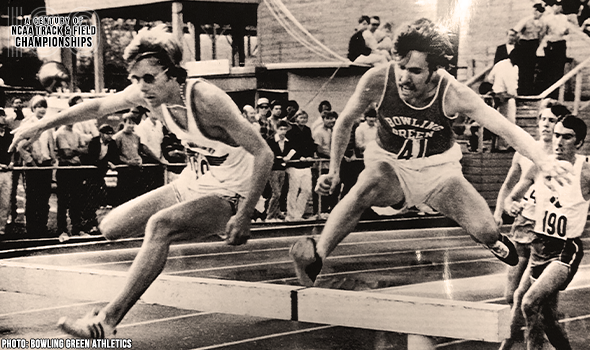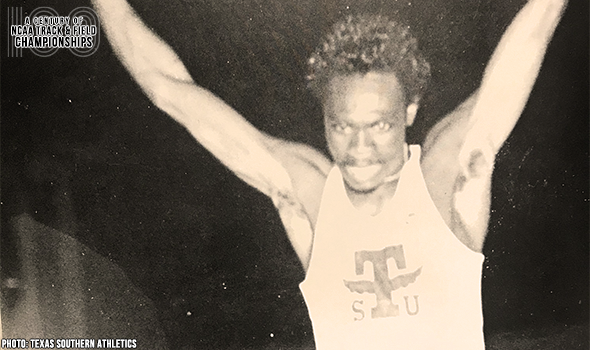
Simpson Sprints To All-Time Mark In 1929
George Simpson of Ohio State was ahead of his time.
In 1929, Simpson used starting blocks – then a recent innovation – in the final of the 100 yards at the NCAA Track & Field Championships. To wit, the starting blocks hadn’t be around all that long, as the invention was credited to Australian Charlie Booth and his father earlier that year.
Simpson, then a junior for the Buckeyes, scorched the cinder in 9.4 seconds to not only win one of his three career NCAA titles, but set an apparent world record in the process. And while the NCAA allowed the use of starting blocks, the world and U.S. governing bodies did not at the time. Therefore, his 9.4 was never ratified as a world record (It was eventually recognized as the American record 15 years later in 1944).
The final field of the 100 yards was loaded, featuring four men who had equaled the existing world record of 9.5. The others, in order of finish: defending champ Claude Bracey of Rice, Eddie Tolan of Michigan and Cy Leland of TCU. Tolan and Simpson, in fact, equaled the 9.5 WR in prelims.
Simpson was a double winner in 1929, adding a 220-yard victory to help lead Ohio State to its first (and still only) team title at this meet. The Buckeyes won the meet with just four athletes – the smallest winning team until USC (1943) and Arkansas (1996) would match them. Amazingly, Ohio State could have won with just three athletes as the trio of Simpson (20 points), hurdler Richard Rockaway (18) and discus thrower Pete Rasmus (10) accounted for 48 of the Buckeyes’ 50 points (Runner-up Washington had 42).
The NCAA and collegiate track & field will mark a momentous milestone in the spring of 2021 -- the 100th anniversary of the NCAA Championships and with that, the NCAA Track & Field Championships. In June 1921, the University of Chicago hosted the first track & field championships in NCAA history.
This point can’t be emphasized enough: Not only was the event the first for NCAA track & field, but the first championships for any sport under the sponsorship of the NCAA.
To celebrate, over each of the next 365 days, the U.S. Track & Field and Cross Country Coaches Association (USTFCCCA) will celebrate moments, student-athletes, and coaches that have made a century’s worth of championships special. From humble beginnings to important historical milestones to the modern-day, collegiate track & field has evolved with the American society.
The 2021 edition of the NCAA Division I Outdoor Track & Field Championships begin with preliminary round action on May 27-29 in Jacksonville, Fla., and College Station, Texas. The championships final site and culmination of the celebration is slated for June 9-12, 2021 at the newly rebuilt Hayward Field in Eugene, Ore.

Bagyula Boasted Incredible Pole Vault Prowess
Istvan Bagyula won three consecutive pole vault titles at the NCAA DI Outdoor T&F Championships between 1990 & 1992. He was the first to clear 19 feet (5.80m) in 1991.

Rotich Went Back-To-Back-To-Back In Steeple
Anthony Rotich won three consecutive steeplechase titles, doing so from 2013 to 2015. His 8:21.19 from 2013 is the ninth fastest mark in meet history.

Lawrence Twins Doubled Down On Outdoor Crowns
Twins Shadae & Shardia Lawrence both won titles at the NCAA Division I Outdoor T&F Championships: Shardae in the discus (2017); Shardia in the triple jump (2019).

Sink Steepled Into The Record Book
Sid Sink won back-to-back titles in the steeplechase at the NCAA Division I Outdoor T&F Championships in 1970 & 1971. He set meet records in each of those years.

Georgia Tech’s Taylor Triumphed In 1998
Angelo Taylor won the 400 Hurdles and doubled back to anchor the winning 4×400 relay team at the 1998 NCAA DI Outdoor Track & Field Championships.

Tennessee’s Skinner Set Javelin MR In 1970
Bill Skinner set a meet record in the javelin of 82.49m (270-8) at the 1970 NCAA Division I Outdoor T&F Championships.

Turner Left No Doubt In 800 Meters
Inez Turner won the 800 meters at the 1995 NCAA Division I Outdoor T&F Championships by 2.24 seconds for what is still the largest margin of victory in meet history.

Cheruiyot Won By Slim Margin In 1989
Kip Cheruiyot beat teammate Peter Rono by 0.03 seconds in the 1500 at the 1989 NCAA DI Outdoor T&F Championships. It was the closest margin of victory since the NCAA adopted FAT.

Emordi Led Texas Southern 1-2 LJ Finish In 1987
Paul Emordi led the only 1-2 finish by teammates in the men’s long jump at the NCAA Division I Outdoor Track & Field Championships in 1987. Emordi won with a leap of 8.25m (27-0¾).

Anchor Down: Tolbert Set 400H CR In 1997
Ryan Tolbert set a collegiate record in the 400 Hurdles of 54.54 at the 1997 NCAA Division I Outdoor T&F Championships. Tolbert also finished third in the open 400!

